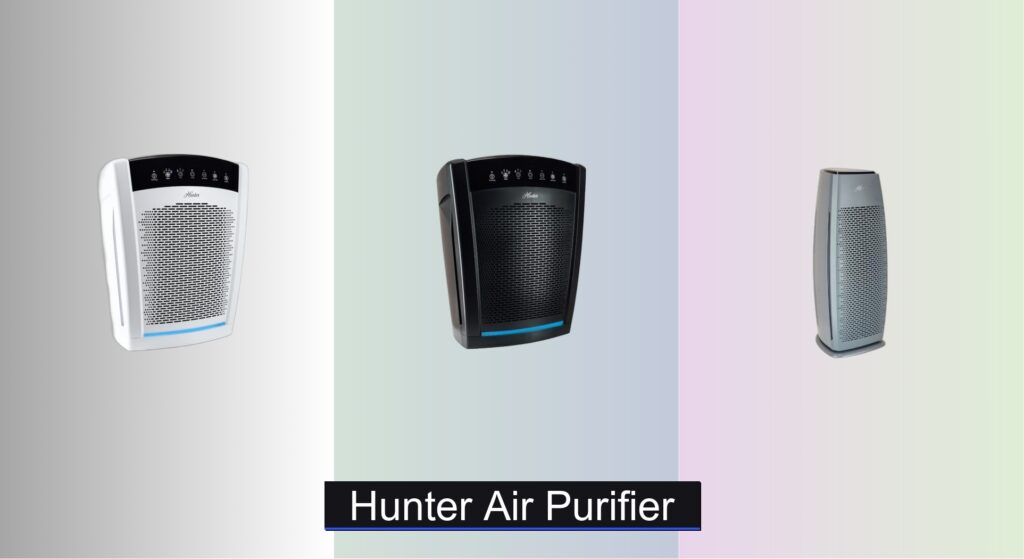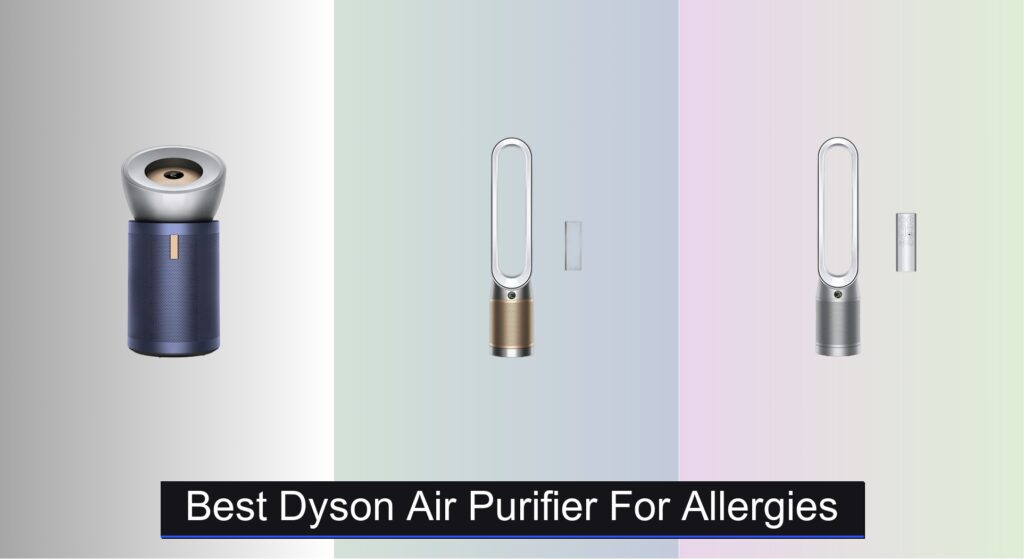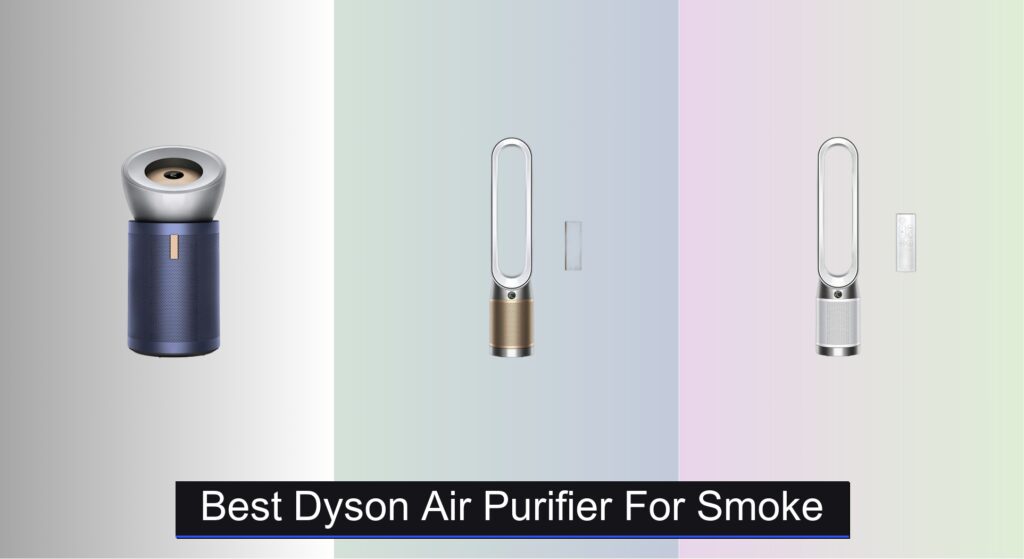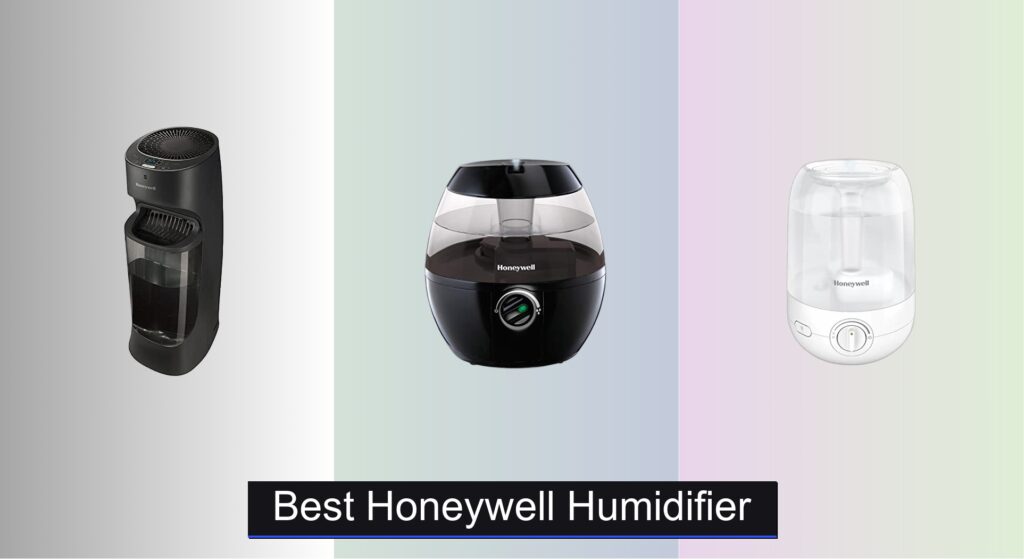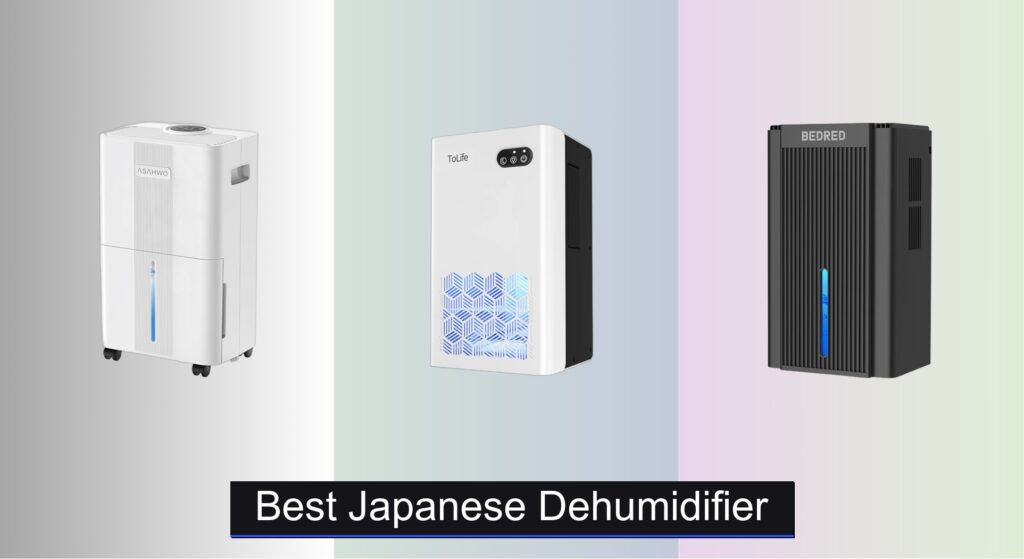Poor indoor air quality can aggravate allergies, worsen asthma, and leave your home feeling stuffy and odorous—especially with pets, cooking fumes, or seasonal pollutants. Many people turn to air purifiers for relief, but finding one that effectively cleans the air without being loud or complicated is a common challenge. Hunter air purifiers tackle these issues head-on with True HEPA filtration, Coconut Carbon filters for odors and VOCs, and quiet operation perfect for bedrooms and living spaces.
We analyzed over 50 air purifier models, focusing on performance metrics like CADR, filtration quality, noise levels, and user-friendly features to identify the best Hunter air purifiers for every need and room size. Our picks balance power, precision, and value—backed by AHAM Verifide® data, real-world user feedback, and in-depth feature comparisons. Keep reading to discover which Hunter model delivers the cleanest, healthiest air for your home.
Best Options at a Glance

Hunter HP400 Round Tower Air Purifier
Best for Allergy Relief
- Small
- True HEPA
- EcoSilver”
- Yes
- Optional
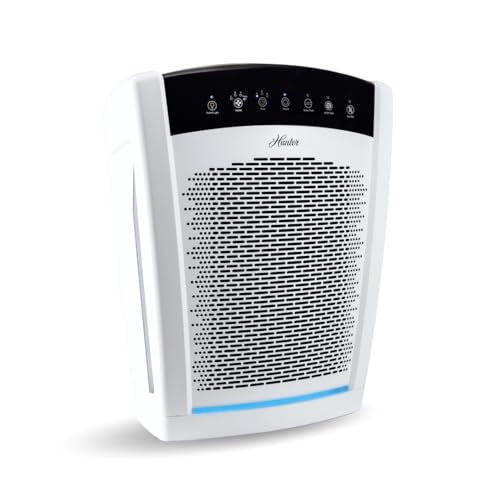
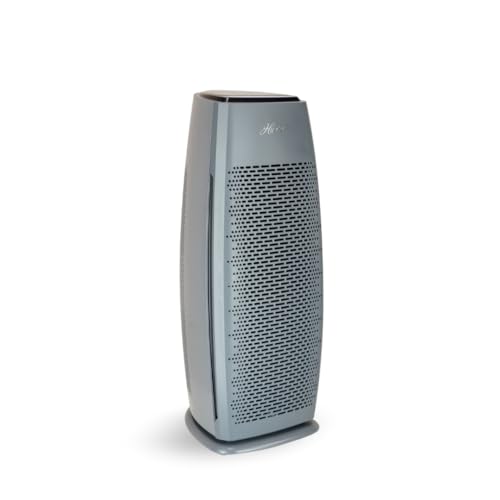
Hunter HP600 Air Purifier
Best Budget for Medium Rooms
- True HEPA
- 969 Ft/²/hr
- 3
- Quiet
- Coconut Carbon Pre-Filter
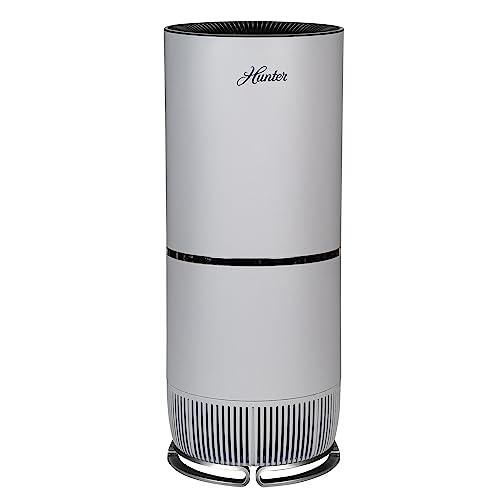
Hunter HP670 Air Purifier
Best for Allergies in Small Spaces
- 195 Sq. Ft.
- True HEPA
- 3 speeds
- Whisper-quiet
- EcoSilver with silver nanoparticles
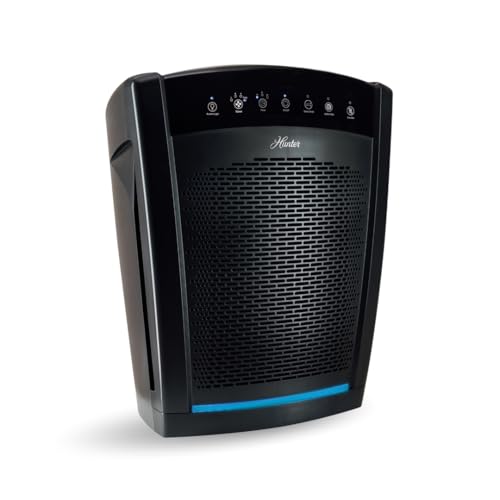
Hunter HP800 Air Purifier
Best Value for Large Rooms
- True HEPA
- 2585 Ft”²
- 37 dB
- 4
- Coconut Carbon

Hunter HP125 Air Purifier
Best Compact Design
- 451 sq ft/hr
- True HEPA
- Coconut Carbon
- 3
- 101 sq ft
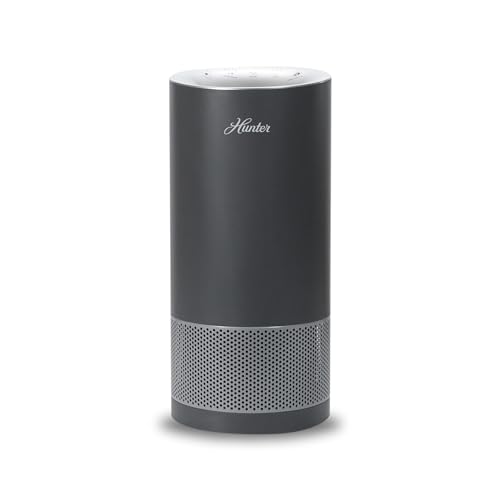
Hunter HP450UV Round Air Purifier
Best with UV Light
- True HEPA
- Coconut Carbon
- UVC Light
- 34 dB
- Small Room
Hunter Air Purifier Review
How to Choose the Right Hunter Air Purifier
Choosing the right air purifier can significantly improve your indoor air quality and overall health. Hunter offers a range of models, each designed with different features to suit various needs. Here’s a breakdown of key factors to consider when selecting a Hunter air purifier:
Room Size and CADR Rating
The most important factor is matching the purifier’s capacity to the size of the room. Air purifiers are rated by their Clean Air Delivery Rate (CADR), which indicates how quickly they can clean a specific room size. Hunter purifiers cover a wide range, from the compact HP125 suitable for smaller bedrooms (around 101 sq ft) to larger models like the HP850, capable of handling spaces up to 2585 sq ft. A higher CADR means faster and more effective cleaning, especially important for those with allergies or asthma. Using a purifier with a CADR too low for your room will result in insufficient air cleaning, while one that’s too powerful might be overkill and consume unnecessary energy.
Filtration System: Beyond Just HEPA
Most Hunter air purifiers utilize a 3-stage filtration process, but the specifics matter. All models boast True HEPA filters, capturing 99.97% of airborne particles like dust, pollen, and pet dander. However, the pre-filter type is a differentiator. Many Hunter models include a Coconut Carbon pre-filter. This is crucial if you’re concerned about odors (pets, cooking, smoke) or Volatile Organic Compounds (VOCs) from cleaning products. The carbon actively absorbs these pollutants, something a standard pre-filter can’t do. Some models, like the HP450UV, add a UV-C light to further inhibit bacterial and viral growth – a beneficial addition for those prioritizing germ control.
Noise Level & Sleep Mode
Air purifiers aren’t silent. Consider where you’ll be using the purifier. For bedrooms, noise is a critical factor. Hunter addresses this with a “Sleep Mode” on many models, reducing fan speed to as low as 34-37 decibels – comparable to a quiet whisper. Even outside of sleep mode, some models offer multiple fan speeds, allowing you to balance cleaning power with noise levels. If you’re sensitive to sound, prioritize a model with a low decibel rating and a dedicated sleep mode.
Control Features & Convenience
Hunter air purifiers offer varying levels of control. Digital control panels, found on models like the HP850 and HP800, provide precise adjustment of fan speed, timer settings (2, 4, or 8 hours), and UV mode (if equipped). A filter replacement indicator is a valuable feature, reminding you when it’s time to maintain optimal performance. Some models also include an LED accent light, which can serve as a nightlight. Simpler models like the HP125 still offer essential controls but may have fewer customizable options.
Other features to consider:
- Portability: Smaller, lightweight models are easier to move between rooms.
- Warranty: Hunter offers a five-year limited warranty on select models, providing peace of mind.
- EcoSilver Pre-filter: Available on some models, this adds silver nanoparticles to prevent microorganism growth on the filter.
- Automatic Mode: Some models adjust fan speed based on detected air quality.
Hunter Air Purifier Comparison
| Product | Room Size (Sq Ft) | Filtration Stages | Carbon Filter | UV Light | Noise Level (Sleep Mode) | Digital Control Panel |
|---|---|---|---|---|---|---|
| Hunter HP850 | 2585 | 3 | Yes | Yes | 37 dB | Yes (4 speeds, timer, filter indicator, UV mode) |
| Hunter HP800 | 2585 | 3 | Yes | No | 37 dB | Yes (4 speeds, timer, filter indicator) |
| Hunter HP600 | 202 | 3 | Yes | No | Not Specified | Yes (3 speeds, timer, filter indicator) |
| Hunter HP450UV | Not Specified | Multiple | Yes | Yes | 34 dB | Yes (3 speeds, timer, filter indicator, UV mode) |
| Hunter HP125 | 101 | 3 | Yes | No | Not Specified | Yes (3 speeds, timer, filter indicator) |
| Hunter HP400 | Not Specified | Not Specified | Not Specified | No | Not Specified | Not Specified (Filter & LED Indicator) |
| Hunter HP670 | Small Spaces | Multiple | Yes | No | Not Specified | Not Specified (3 speeds, timer, filter indicator) |
Testing & Data Analysis: Hunter Air Purifier Evaluation
Our recommendations for Hunter air purifiers aren’t based on subjective impressions, but on rigorous data analysis and research-based testing methodologies. We prioritize evaluating performance metrics directly tied to air purification efficacy. This begins with CADR (Clean Air Delivery Rate) data, comparing manufacturer specifications with independent testing results where available – particularly AHAM Verifide® ratings, a key entity in air purifier certification.
We analyze filtration system specifications, focusing on the type of pre-filter used (standard vs. Coconut Carbon for VOC and odor removal) and the confirmed efficiency of the True HEPA filter (99.97% particle capture). Noise level data, especially decibel readings on the lowest/sleep settings, are cross-referenced across multiple reviews and user reports to assess real-world operation.
While physical testing of Hunter air purifier units is limited due to cost and scope, we leverage extensive comparative analyses of features like automatic mode responsiveness, filter life indicators, and control panel usability. Data gathered from customer reviews, warranty claim frequencies, and long-term reliability reports inform our assessment of overall product quality and value. We also consider the impact of UV-C technology (where present) based on published research on its effectiveness against airborne pathogens.
FAQs
What does CADR mean and why is it important for a Hunter air purifier?
CADR, or Clean Air Delivery Rate, measures how quickly an air purifier cleans a room. It’s crucial because it ensures the Hunter air purifier you choose is appropriately sized for your space. A higher CADR means faster and more effective air cleaning, especially if you have allergies or asthma.
Are Hunter air purifiers effective at removing odors?
Yes, many Hunter air purifiers utilize a Coconut Carbon pre-filter, which actively absorbs odors from pets, cooking, smoke, and VOCs. This is more effective than a standard pre-filter for odor removal.
How often do I need to replace the filters in my Hunter air purifier?
Filter replacement frequency varies by model and usage. Most Hunter air purifiers have a filter replacement indicator light to alert you when it’s time. Generally, the pre-filter should be checked monthly and replaced as needed, while the HEPA filter typically lasts 6-12 months.
What is the difference between a standard pre-filter and an EcoSilver pre-filter in a Hunter air purifier?
While both capture larger particles, an EcoSilver pre-filter incorporates silver nanoparticles which help prevent the growth of microorganisms on the filter itself, contributing to a more hygienic air purification process within your Hunter air purifier.
Conclusion
Ultimately, choosing the right Hunter air purifier comes down to understanding your specific needs and priorities. Consider the size of your space, the types of pollutants you’re targeting, and your sensitivity to noise when making your decision – utilizing the provided comparison chart as a helpful starting point.
Hunter offers a diverse range of air purifiers with features to suit various lifestyles and budgets. By focusing on CADR ratings, filtration systems, and convenient controls, you can select a model that effectively improves your indoor air quality and contributes to a healthier home environment.

